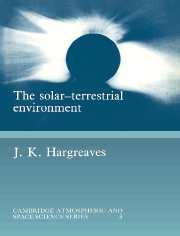 The Solar-Terrestrial Environment
The Solar-Terrestrial Environment Published online by Cambridge University Press: 29 January 2010
…this most excellent canopy, the air, look you, this brave o'erhanging firmament, this majestical roof fretted with golden fire, why, it appears no other thing to me than a foul and pestilent congregation of vapours.
W. Shakespeare, Hamlet, Act II Scene (ii)Vertical structure
Nomenclature of atmospheric vertical structure
The static atmosphere is described by the four properties, pressure (P), density (ρ), temperature (T) and composition. Between them these properties determine much of the atmosphere's behaviour. They are not independent, being related by the universal gas law which may be written in various forms (Equations 2.5–2.7). For our purposes the form
P = nkT, (Equation 2.7)
where n is the number of molecules per unit volume, is particularly useful. The quantity ‘n’ is properly called the concentration or the number density, but density alone is often used when the sense is clear.
The regions of the neutral atmosphere are named according to various schemes based in particular on the variations with height of the temperature, the composition, and the state of mixing. Figure 4.1 illustrates the most commonly used terms. The primary classification is according to the temperature gradient. In this system the regions are ‘spheres’ and the boundaries are ‘pauses’. Thus the troposphere, in which the temperature falls off at 10 K/km or less, is bounded by the tropopause at a height of 10–12 km. The stratosphere above was originally thought to be isothermal, but in fact is a region where the temperature increases with height. A maximum, due to heating by ultra-violet absorption in ozone, appears at about 50 km and this is the stratopause.
To save this book to your Kindle, first ensure [email protected] is added to your Approved Personal Document E-mail List under your Personal Document Settings on the Manage Your Content and Devices page of your Amazon account. Then enter the ‘name’ part of your Kindle email address below. Find out more about saving to your Kindle.
Note you can select to save to either the @free.kindle.com or @kindle.com variations. ‘@free.kindle.com’ emails are free but can only be saved to your device when it is connected to wi-fi. ‘@kindle.com’ emails can be delivered even when you are not connected to wi-fi, but note that service fees apply.
Find out more about the Kindle Personal Document Service.
To save content items to your account, please confirm that you agree to abide by our usage policies. If this is the first time you use this feature, you will be asked to authorise Cambridge Core to connect with your account. Find out more about saving content to Dropbox.
To save content items to your account, please confirm that you agree to abide by our usage policies. If this is the first time you use this feature, you will be asked to authorise Cambridge Core to connect with your account. Find out more about saving content to Google Drive.